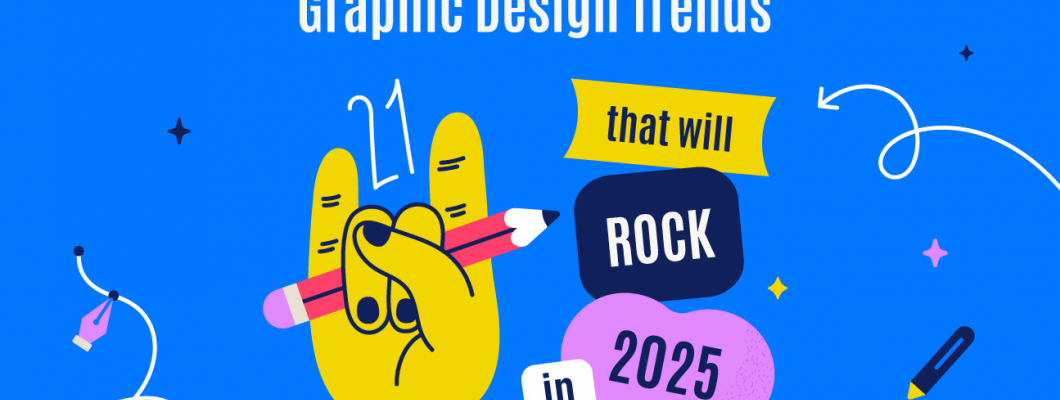
Introduction
Graphic design is evolving at lightning speed, driven by technology, shifting user preferences, and global design innovation. In 2025, the graphic design landscape is being reshaped by powerful AI tools, immersive 3D visuals, and daring typography choices. These trends are not only transforming how we design but also how audiences connect with content.
Whether you’re a creative professional or a business looking to stay visually relevant, understanding these trends will help you stand out in a competitive digital world.
1. AI Tools Are Redefining the Creative Process
Artificial Intelligence has moved beyond automation and into the creative realm. In 2025, AI tools have become integral to the design process—assisting with everything from generating layouts and color palettes to producing original artwork based on text prompts.
AI-powered platforms like Adobe Firefly, DALL·E, Canva Magic Design, and Runway ML empower designers to work faster and more creatively. These tools enable idea generation, real-time design adjustments, and even custom branding assets in minutes.
Rather than replacing designers, AI acts as a creative partner—speeding up workflows, eliminating repetitive tasks, and freeing up time for strategic thinking and storytelling. This collaboration between human creativity and machine intelligence is setting a new standard for productivity and innovation in graphic design.
2. 3D Design Goes Mainstream
3D design is no longer reserved for high-end visual effects or game development. In 2025, it has gone mainstream—used in everything from website elements and product mockups to animated explainer videos and digital ads.
Tools like Blender, Spline, and Figma’s 3D integrations have made 3D design more accessible and easier to integrate into traditional workflows. With enhanced realism, depth, and interactivity, 3D visuals are helping brands create more immersive and emotionally engaging content.
E-commerce platforms are using 3D product views, UI/UX designers are incorporating depth in interface elements, and digital artists are blending 2D and 3D to tell rich, multi-dimensional stories. As users demand more interactive experiences, 3D design will remain a key driver of engagement and innovation.
3. Bold Typography Takes the Spotlight
Typography in 2025 is loud, expressive, and unapologetically bold. Designers are using type not just for communication—but as the centerpiece of the entire composition. Oversized fonts, kinetic typography (animated type), and unconventional layouts are giving brands unique voices and strong visual identities.
Mixed font pairings, type-driven design, and custom font development are on the rise as brands seek to stand out in crowded markets. In digital spaces, animated text draws attention and adds motion to otherwise static pages. These bold typography choices are especially effective in social media, ads, and web design where grabbing attention quickly is key.
The focus is no longer just on legibility—it’s about impact. Typography is being used as art, narrative, and branding all at once.
4. Vibrant Minimalism Is the New Normal
Minimalism has always been a popular design choice, but in 2025, it’s getting a fresh twist. Designers are blending clean, simple layouts with vibrant colors, gradients, and geometric shapes to create visually striking yet uncluttered visuals.
This trend—often called “neo-minimalism”—retains the functionality and clarity of traditional minimalism but adds excitement through color and form. The result is a sleek, modern design that communicates effectively while still catching the eye.
Websites, apps, and digital ads are embracing this style to improve user experience without sacrificing visual appeal. It’s a great balance between aesthetics and usability, especially for mobile-first content.
5. Sustainability-Inspired Visuals
As environmental awareness becomes a core brand value, design is reflecting this shift. In 2025, sustainability is not just a theme—it’s a visual language. Designers are using earthy tones, natural textures, organic shapes, and eco-friendly imagery to connect with conscious consumers.
These visuals help brands communicate authenticity, responsibility, and care for the planet. They’re especially popular in sectors like food, fashion, wellness, and technology, where consumers expect transparency and ethical practices.
Designers are also adopting greener workflows—using digital mockups, minimizing print runs, and choosing eco-conscious platforms. This trend proves that good design can look great and do good at the same time.
6. Motion Graphics Dominate Digital Content
Static content is no longer enough to grab attention in fast-scrolling digital environments. In 2025, motion graphics are essential—whether through subtle UI animations, looping social media clips, or full-scale video production.
Animated visuals help explain complex ideas quickly, bring branding to life, and increase user engagement. Short-form videos (like Reels and TikToks) thrive on motion and are often more memorable than still images.
Motion design also plays a critical role in UX/UI, guiding users through digital experiences with animated buttons, transitions, and feedback effects. It’s an exciting space where design meets storytelling.
Conclusion: Designing the Future in 2025
The graphic design trends of 2025 showcase a powerful blend of technology, creativity, and purpose. AI tools are revolutionizing workflows, 3D visuals are enriching storytelling, and bold typography is redefining how we communicate. These trends are not just stylistic—they represent a shift in how people experience and interact with visual content.
To stay ahead, designers and brands must be willing to experiment, adapt, and embrace these innovations. By aligning your creative strategy with these future-forward trends, you can deliver designs that resonate, perform, and inspire.
Whether you're a professional designer, business owner, or content creator—2025 offers incredible opportunities to rethink, reimagine, and redefine what great design looks like.

Leave a Comment